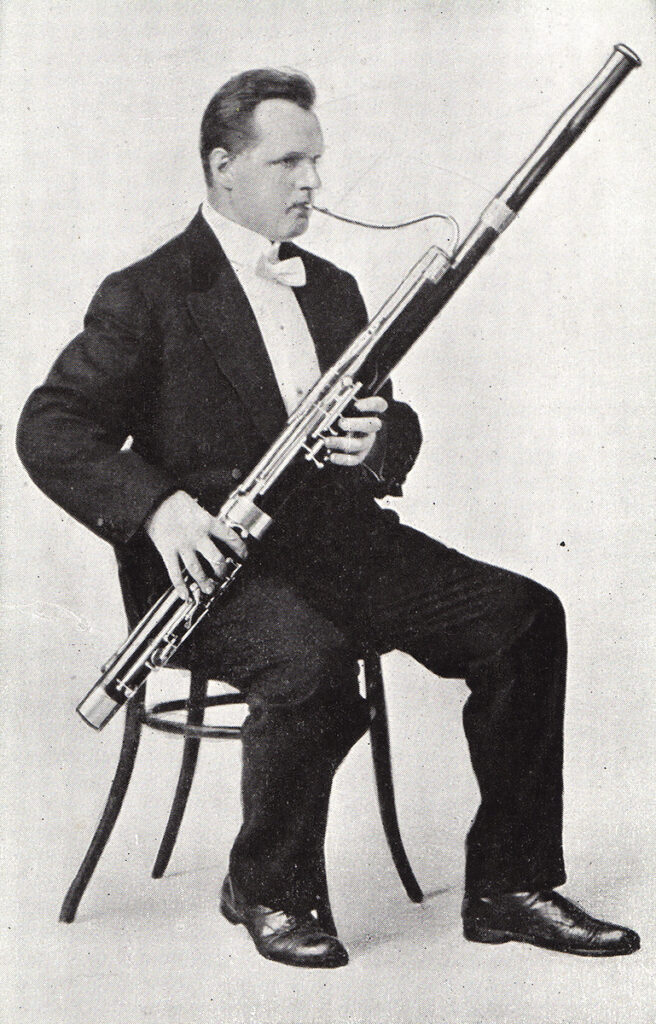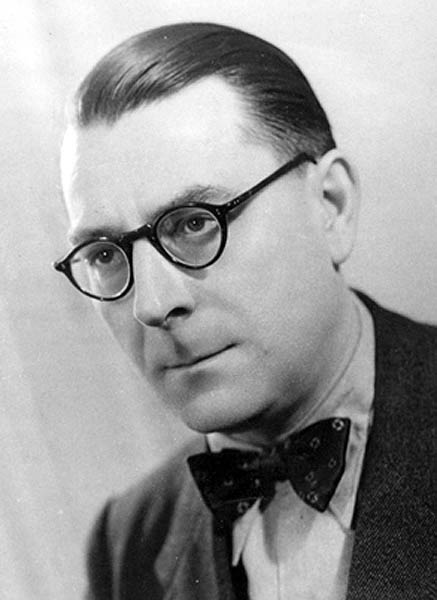Most of the early recordings that feature the bassoon did so in a comical fashion. A handful of artists recorded Quentin Ashlyn’s song “The Bassoon” in the first decades of the 20th century, and I have in my collection a couple of very strange (at least to modern ears) “laughing records” from the same era that include the bassoon. In 1911, Carl Borgwald recorded Julius Fučík’s classic “Der Alte Brummbär” in 1911 (released as “Polka Fantastique” in the U.S.). And in 1918, Edison released two somewhat silly piccolo/bassoon duets: “The Elephant and The Fly” and “The Nightingale and the Frog”, both featuring Benjamin Kohon, who would later become principal bassoonist of the New York Philharmonic. The earliest “serious” bassoon piece on disc (the earliest that I’ve been able to locate, anyway) was not the Mozart Concerto, as one might guess. Rather, it was Carl Maria von Weber’s Andante e Rondo Ongarese. In fact, this Romantic showpiece was recorded three separate times between 1920 and 1938.
Aside from being historical curiosities, these recordings give us a glimpse of early twentieth century bassoon playing. And as far as I can tell, none of these recordings have ever been re-released. Below you will find copies of all three, digitized from discs in my collection. I’ve applied a bit of noise reduction and removed the worst of the pops and clicks, but these are far from professional-quality transfers. I’d recommend listening to these on headphones or real speakers, as they may be a bit difficult to hear on laptop, tablet, or phone speakers.
The first two of these were in fact made by the same man: William Gruner, who played bassoon in the Philadelphia Orchestra 1906–1917 and 1929–1951. Gruner was born in Berlin on January 12, 1883 and arrived in the United States aboard the S.S. Deutschland in April 1906. He became a U.S. citizen in 1914, and lived near Philadelphia until his death in February 1971. In the period between his two stints with the Philadelphia Orchestra (1917–1929), Gruner worked for the Victor Talking Machine Company, making numerous recordings with the Victor Orchestra and numerous smaller groups.1John Ardoin, The Philadelphia Orchestra: A Century of Music (Philadelphia: Temple University Press, 1999); William Gruner, Petition for Naturalization, March 20, 1913, Naturalization Petitions for the Eastern District of Pennsylvania, 1795-1930 (Washington, D.C.: National Archives and Records Administration, microfilm series M1522, roll 93), 335; William Gruner, 165-03-6373, Social Security Death Index, 1935-Current (Provo, UT, USA: Ancestry.com Operations Inc, 2011); William Gruner, Draft Registration Card, September 12, 1918, World War I Selective Service System Draft Registration Cards, 1917-1918, (Washington, D.C.: National Archives and Records Administration, microfilm series M1509, roll PA83), 278.
Gruner and the Victor Orchestra first recorded Andante e Rondo Ongarese in June 1920. They recorded ten takes over the space of three recording sessions in Victor’s Camden, New Jersey studios. The last of these, recorded on June 24th, was issued as “Hungarian Fantasie” on the B side of Victor 18684, a ten-inch 78rpm disc. The piece was severely cut down to fit this format: it lasts a mere three minutes and thirteen seconds. (For comparison, complete recordings I have by Milan Turkovic, Nadina Mackie, and Masahito Tanaka clock in at 9:53, 9:02, and 9:20, respectively.) After the initial 16 measures of the Andante, a two bar orchestral transition launches us right into the Rondo. The Rondo is a bit more substantial, but is missing huge chunks (including most of that dreaded last page of 16th-note triplets). The end of the piece has been rewritten, too. Hear it for yourself:
When Gruner made this recording in 1920, the technology involved was quite similar to that invented by Thomas Edison 43 years earlier: the performers played into a large horn that transmitted sound waves to a flexible diaphragm connected to a stylus that cut the sound directly onto a wax disc. This method produced recordings with limited frequency and dynamic range and required performers to crowd around a single horn to be heard. But in 1925 Victor (and many of their competitors) adopted a new electrical recording process that used microphones, vacuum tube amplifiers, and an electromagnetic recording head. This system allowed for much greater dynamic and frequency response, and produced a generally much better sounding recording.
Gruner and the Victor Orchestra returned to the studio on October 19, 1926, and recorded an additional five takes of the Weber with the new electrical recording system. They used the same pared-down arrangement — electrical recording did nothing to mitigate the format’s time constraints. This new recording was released in June 1927 as the B side of Victor 20525, another ten-inch 78rpm disc. Although Victor didn’t set about re-recording their entire catalog after switching to electrical recording, this is in instance in which they clearly wanted to re-create an earlier disc. The A sides of the two discs are recordings of Tourbillon (Whirlwind), a piece for flute and piano by Adolph Krantz, albeit featuring different performers.2The earlier disc (Victor 18684) features flutist Arthur Brooke of the Boston Symphony, while the performance on the later disc (Victor 20525) is by Clement Barone, a member of the Victor Orchestra and formerly principal flutist of the Philadelphia Orchestra.
If you made it all the way through Gruner’s 1920 recording, you probably don’t need to listen to all of this one. His interpretation doesn’t change appreciably, although it is interesting to hear the differences between the two recording processes.
The French bassoonist Fernand Oubradous recorded Andante e Rondo Ongarese in Paris in 1938, accompanied by the Orchestre de la Société des Concerts du Conservatoire under the direction of Roger Désormière. Oubradous was born in Paris on February 12, 1903. He won his Premiere prix from the Paris Conservatoire in 1923 — after only a single year of bassoon study. He played with the Paris Opéra, the Orchestre Lamoureux, the Orchestre de la Société des Concerts du Conservatoire, and the Trio d’Anches de Paris. In addition to Weber’s Andante e Rondo Ongarese, Oubradous recorded concerti by Mozart, Weber, and Boismortier and a great deal of chamber music. But his first job after graduating from the Conservatoire was as music director of the Théâtre de l’Atelier, and he received much acclaim as a conductor throughout his career. Oubradous died in Paris in January 1986.3Jean-Pierre Seguin, "Fernand Oubradous: A Half-Century of Woodwind History," trans. Philip Gottling, The Journal of the
International Double Reed Society, no. 14 (1986). For more on Oubradous, see these two sites (both in French): fernand.oubradous.free.fr and Fernand Oubradous — Site de l’association Fou de Basson.
Oubradous’s recording of the piece is nearly complete, thanks to it being issued on both sides of a twelve-inch 78rpm disc (L’Oiseau-Lyre O.L. 14). This is likely attributable to the fact that Éditions de l’Oiseau-Lyre has always had a more specialist and scholarly focus than more mass-market companies like Victor. Side A is the Andante, which is just over four minutes long. The Rondo (on side B) is slightly longer at four minutes and sixteen seconds. The Rondo had to be cut down a bit to fit; forty-two measures have been excised. This is mostly mostly repeated themes and sections of orchestral interludes, but the entire last statement of the rondo theme has been removed as well. There’s one other interesting change: the four measures of quarter-note trills in the middle of the last flashy section have been taken out of the solo part and given to one of the orchestral bassoonists!
It’s clear that recording technology and disc manufacture had improved quite a bit in the 12 years since Gruner’s second recording. The bassoon is clearer and more present (the fact that he was playing a French bassoon helps, too), and the orchestra’s sound has far more depth and definition. Frankly, the quality of the bassoon playing is much higher, as well. Although this particular recording hasn’t been rereleased, you can occasionally find Oubradous’s Mozart Concerto on CD on Amazon, or as mp3s here.
Notes:
- 1John Ardoin, The Philadelphia Orchestra: A Century of Music (Philadelphia: Temple University Press, 1999); William Gruner, Petition for Naturalization, March 20, 1913, Naturalization Petitions for the Eastern District of Pennsylvania, 1795–1930 (Washington, D.C.: National Archives and Records Administration, microfilm series M1522, roll 93), 335; William Gruner, 165–03-6373, Social Security Death Index, 1935-Current (Provo, UT, USA: Ancestry.com Operations Inc, 2011); William Gruner, Draft Registration Card, September 12, 1918, World War I Selective Service System Draft Registration Cards, 1917–1918, (Washington, D.C.: National Archives and Records Administration, microfilm series M1509, roll PA83), 278.
- 2The earlier disc (Victor 18684) features flutist Arthur Brooke of the Boston Symphony, while the performance on the later disc (Victor 20525) is by Clement Barone, a member of the Victor Orchestra and formerly principal flutist of the Philadelphia Orchestra.
- 3Jean-Pierre Seguin, “Fernand Oubradous: A Half-Century of Woodwind History,” trans. Philip Gottling, The Journal of the
International Double Reed Society, no. 14 (1986).
- 1John Ardoin, The Philadelphia Orchestra: A Century of Music (Philadelphia: Temple University Press, 1999); William Gruner, Petition for Naturalization, March 20, 1913, Naturalization Petitions for the Eastern District of Pennsylvania, 1795–1930 (Washington, D.C.: National Archives and Records Administration, microfilm series M1522, roll 93), 335; William Gruner, 165–03-6373, Social Security Death Index, 1935-Current (Provo, UT, USA: Ancestry.com Operations Inc, 2011); William Gruner, Draft Registration Card, September 12, 1918, World War I Selective Service System Draft Registration Cards, 1917–1918, (Washington, D.C.: National Archives and Records Administration, microfilm series M1509, roll PA83), 278.
- 2The earlier disc (Victor 18684) features flutist Arthur Brooke of the Boston Symphony, while the performance on the later disc (Victor 20525) is by Clement Barone, a member of the Victor Orchestra and formerly principal flutist of the Philadelphia Orchestra.
- 3Jean-Pierre Seguin, “Fernand Oubradous: A Half-Century of Woodwind History,” trans. Philip Gottling, The Journal of the
International Double Reed Society, no. 14 (1986).




12 Responses
Interesting post.…I’ve wanted to get a digital copy of the Eli Carmen recording.….it was done some time latter, and it would make an interesting comparison too. By the way I’m a “blogging” bassoonist too…excellent post.
Thanks, Vincent. After a comment by Harry Searing on Facebook, I found the Carmen recording on YouTube:
. Haven’t had a chance to really sit down and listen in a focused way yet, but will do so later. It’s just the Rondo, though!
Thanks also for the link to your site. I’ve added you to my links to the right and to my personal reading list, as well.
Dear Mr. Wells,
My name is Volodymyr Runchak.
I am a Ukrainian composer, conductor and the artistic director of the chamber ensemble, New Music in Ukraine.
I would very much like the opportunity of creative collaboration with you.
I have written piece for bassoon *, which I would like to offer for your consideration for performance.
If you would like to have my score and CD, please let me know where to mail them.
I thank you for the opportunity to send you this letter, and I look forward to your answer.
Respectfully,
Volodymyr Runchak
Drahomanova st. 22, apt. 163,
02068, Kyiv, Ukraine
tel: +38 044 5704135
fax: +38 044 2342260
e‑mail: v_runchak@voliacable.com
*
The Bassoonist’s notebook (2 pieces for bassoon solo, 3 pieces for bassoon and piano)
Homo ludens XI or several competition SMS for bassoonist and members of the jury
[…] David Wells shares and comments on early 20th-century recordings of the Weber Andante e Rondo Ongarese by William Gruner […]
I bought the fine Heckel bassoon #6131 played on the later recording from Mr. Gruner in 1968. I played it professionally and eventually sold it.
Interesting! Now you’ve got me thinking about tracing the bassoons that were played on various recordings…
I’ve just read your article on William Gruner and his bassoon recording(s) for Victor. Mr. Gruner was my grandfather. I have been gathering information for a scrapbook re my grandparents, so this was delightful to read. I also just listened to his recording on another website. I see your comment from Mr. Weait — I have a signed photo of him that was in my grandfather’s possession. Small world!
Wow, small world indeed! I’m glad you found my post, particularly as you’re in the process of making a scrapbook about your grandparents.
Hello Mr. Wells,
How nice to discover a really well-managed bassoon website, with historical performances no less. I produce/host a weekly radio program in New York City, specializing in historical performances — mostly piano and strings, with excursions elsewhere. This week I discovered Fernand Oubradous while watching a movie. His name appears in the opening credits, as a musical arranger, for Robert Bresson’s 1959 film “Pickpocket”. Wondering who he was, I found his Mozart Concerto recording from 1936, with Bigot. I aired the very fine performance this morning. I am not a connoiseur of bassoon playing, but his performance seemed exemplary: clear, clean, virtuosic, with beautiful tone, and extremely musical. He does have a “French” sound, especially his articulation.
Would you happen to know who composed the first movement cadenza? Wow! Maybe it was composed by Oubradous? His playing will certainly be sent out over WBAI-FM again! Keep up the great work. I’m downloading a few of your uploads now 🙂
Thanks for your comments, and my apologies for being so slow to reply!
Oubradous’s Mozart recording is indeed quite virtuosic, and it’s also the earliest recording of that concerto I’m aware of. His cadenza from the first movement was written by none other than Jacques Ibert! Ibert also wrote a cadenza for the second movement, but presumably the need to squeeze that movement onto a single 12″ side prevented them from recording it. The two cadenzas were published by Leduc, and are now available in a new edition by Trevco.
Oubradous also recorded “Mozart’s 2nd Bassoon Concerto,” which was later determined to be spurious (L’Oiseau-Lyre 40–41). Devienne has been put forward as a possible author, but that’s shaky, too.
By the way, your transfers of the Weber are fine, but you may want to consider saving a bit more of those high frequencies, to restore some of the “bite” to the sound. The ear is very forgiving of surface noise if bright-sounding music comes along with it. Again, great site!
Noted – thanks!